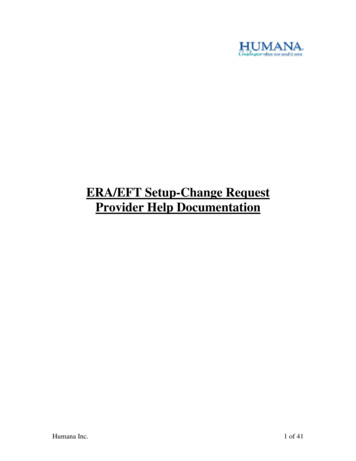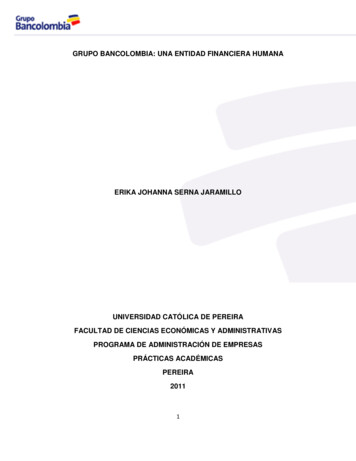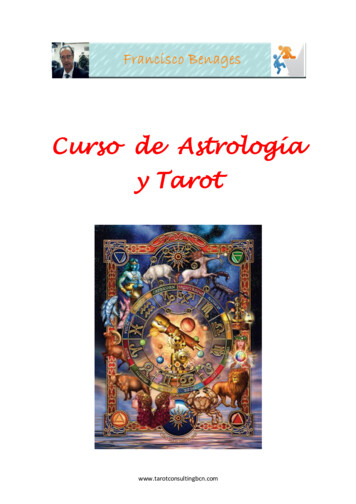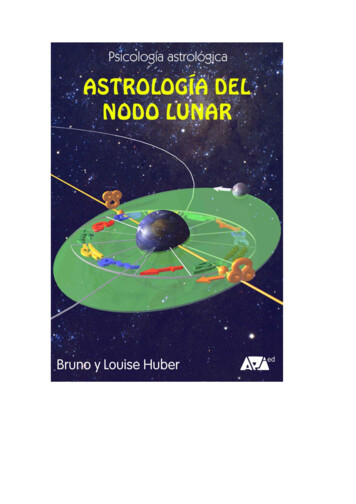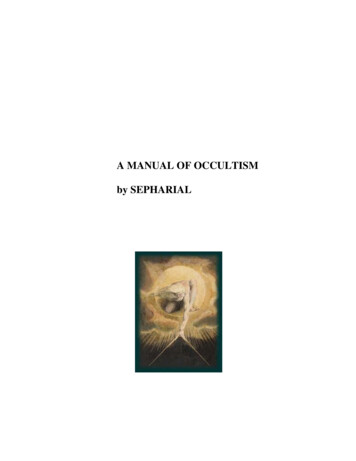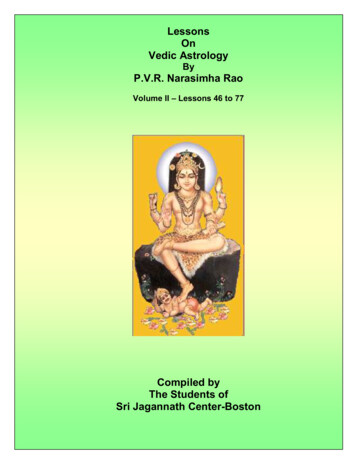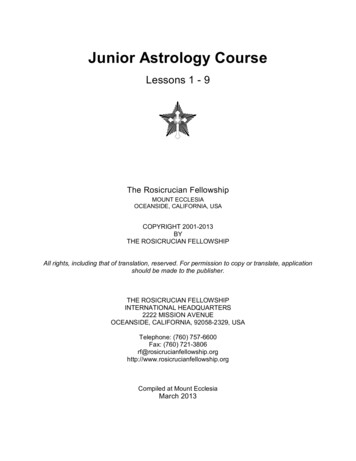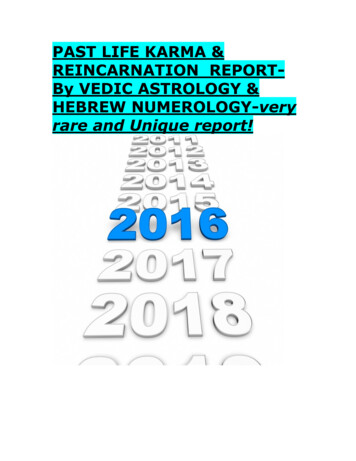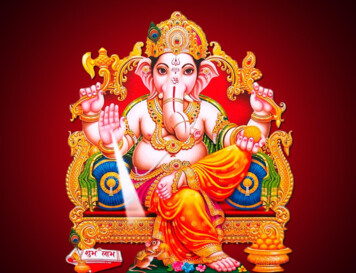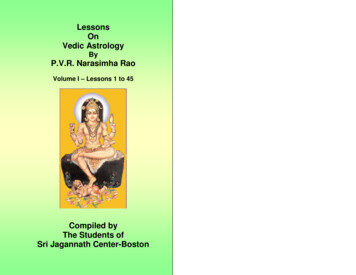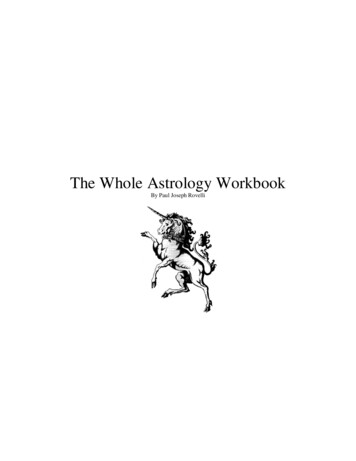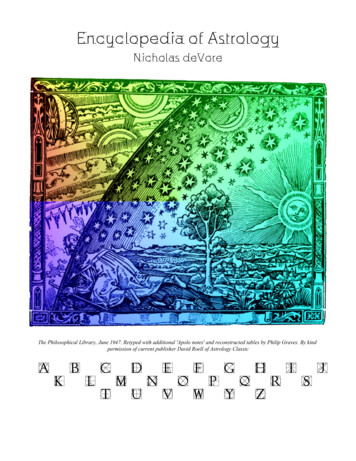
Transcription
Encyclopedia of AstrologyNicholas deVoreThe Philosophical Library, June 1947. Retyped with additional 'Apolo notes' and reconstructed tables by Philip Graves. By kindpermission of current publisher David Roell of Astrology ClassicABKCLDMTENUFOVGPWHQYIRZJS
AAccidental Ascendant. A device employed by Evangeline Adams whereby to draw Horaryinterpretations from a natal Figure. In applying this method one determines the Ascendant forthe moment the question is propounded, and rotates the Figure until this degree occupies theEast point.Accidental Dignity. See 'Dignities'Acronycal. Said of the rising after sunset, or setting before sunrise, of a planet that is inopposition to the Sun, hence in a favorable position for astronomical observation.Acronycal place. The degree the planet will occupy when it is in opposition to the Sun.Active Influence. That which results from an aspect between two or more astrological factors orsensitive points, thereby producing the action that can materialize in an event.Adept. One who has attained to proficiency in any art or science. It may be said of a skilledastrologer who, through spiritual development, has attained to superior powers andtranscendental knowledge concerning the origins and destiny of mankind. Formerly said of analchemist who had attained the 'great secret' - presumably that concerning the 'transmutation ofmetals'. Its modern application is to the transmutation of unfavorable cosmic stimuli and thebaser emotions into nobler impulses - thereby achieving the triumph of mind over matter, and ofthe spiritual over the carnal.Adjusted Calculation Date. A term used in reference to a directed or progressed horoscope, asindicating the date on which the planet culminates. Also termed Limiting Date. See 'Directions'.Advantage, Line of. A term sometimes used with reference to the position of the Moon's
Ascending Node in a Geocentric Figure. The line of advantage runs between the cusps of thethird decanates of the Third and Ninth Houses. A position of the Node East of this line is judgedto be favorable.Related to it are the Arcs of Increased and Dwarfed Stature. From the middle of the First House,clockwise to the middle of the Eighth House, is the arc of Increased Stature, with its peak at cuspof the Twelfth House; and from the middle of the Seventh House, clockwise to the middle of theSecond House, is the Arc of Dwarfed Stature, with its peak at the cusp of the Sixth House. SeeNodes, Moon's.Affinity. A binding by mutual attraction. The Sun is said to have an affinity with all the planets;Mars with Venus, in a magnetic or physical sense; Venus with Jupiter, in a philanthropic senseas one who loves his fellowman; Venus with Mercury, in an artistic sense.Afflicted: (Afflicted by / in affliction with): Unfavorably aspected. Loosely applied to: (a) anyinharmonious aspect to a planet, or (b) to any aspect, particularly the conjunction, parallel,square or opposition, to a malefic planet. Also by some authorities applied to a mundane orzodiacal parallel with, or when, besieged by both Infortunes (q.v.). Some authorities considerthat the sensitive degree on any House cusp can be afflicted, though any such consideration mustbe confined to instances where the birth-moment is known to a certainty.Ages, Astrological. As anciently considered, a period of roughly 2150 years during which thepoint of the Spring Equinox recedes through one sign of the Zodiac of Constellations. Since theconstellations have no precise boundaries, the points of beginning and ending are mereapproximations.However, it is an absurdity to date the beginning of the precessional cycle, of presumably 25,800years, from the particular time in history when it was decided no longer to treat the Equinox as amoving point, but instead to freeze it at 0º Aries. It is probably that midway between theEquinoctial points are the Earth's Nodes, where the plane of its orbit intersects that of the Sun, atan inclination of approx. 50º; but since the Equinoctial Point is now considered as a fixed pointand the motion takes place only within its frame of reference, it appears that a study of the circlewhich the celestial pole describes around the pole of the Ecliptic will be required in order todetermine when it passes an East point, to mark the time of beginning of the first of twelveastrological ages of 2150 years each, into which the precessional cycle is subdivided. On thismanner of reckoning the Earth might now be in the Capricorn Age, as well as any other. At leastthere is no justification for us to consider mankind as now in the Aquarian age, even though arecent astronomical treatise speaks of the Signs of the Zodiac as 'now precessed some 25º westof the constellations of the same name'. Historical records show the Equinox as having oncebegan in Taurus, at which time Taurus was considered to be the first Sign of the Zodiac. See'Precession'.
Air Signs. The mental or intellectual signs: Gemini, Libra, Aquarius. Considered collectively,sometimes termed the Air asterism.Albedo. Literally, whiteness. A measure of the reflecting power of a planet, in ration to itsabsorptive capacity; expressed in a figure which represents the amount of light reflected from anunpolished surface in proportion to the total amount of light falling upon it.The albedo of the Moon and Mercury is 7; Venus 59; Earth 44; and Mars 15. Thus, thechangeable character manifested by Moon and Mercury is seen to be connected in some waywith their low reflective capacity.An entirely different set of Lunar characteristics comes of the fact that as the Moon approachesan opposition to the Sun its surface temperature rises some 70-odd degrees above boiling point,and in consequence it emits a wide band of infra-red frequencies that are several times morepowerful than any of the rays it reflects from the Sun. During the first few minutes of a Lunareclipse, the surface temperature falls to a sub-zero level and the infra-red emanation ceases.The dimly-lit surface of the Moon at the Lunation is due to light reflected back from the Earth,which with its high albedo would appear to the Moon-dweller as four times larger and manytimes brighter than the Moon as seen from Earth.There are some indications that Jupiter emits a ray of its own in addition to its reflected ray, butastrophysicists are not as yet in accord on that point.Almanac. A book or table containing a calendar of days, weeks and months, to which are addedastronomical or other data. Its use dates back at least to the Alexandrian Greeks. The Romanalmanac was the fasti - days on which business could be transacted.The earliest of which we have concise record is that of Solomon Jarchus, 1150 A.D. Purbachpublished one from 1450-6. His pupil Regiomontanus issues the first printed almanac in 1475.The most outstanding almanac maker of the Middle Ages was Nostradamus.All English almanacs were prophetic until the year 1828; and until 1834 the stamp duty was1s.3d. per copy. The first almanac in the U.S. was issued in 1639 by William Pierce. It wasexceeded in popularity by Poor Richard's Almanac (1732-57) issued by Benjamin Franklin.Watkins Almanac, issued since 1868, has an annual circulation of upward of two million copies.The chief Astrological Almanacs of the present epoch are 'Raphael's', first published in 1820,and 'Zadkiel's', first published in 1830. All governments now issue an Ephemeris and a Nauticalalmanac. See 'Ephemeris'.Almuten. The planet of chief influence in a Nativity by virtue of essential and accidentaldignities. Its strength is estimated from: its intrinsic character; its Sign position where posited, itsown Sign, or the Sign in which it is in exaltation; its harmonious aspects from favoring planets;and its elevated position in a geoarc Figure. A term of Arabian origin, seldom employed by
present day astrologers.Altitude. Elevation above the horizon, measured by the arc of a vertical circle. A planet is atmeridian altitude when it is at the Midheaven, the cusp of the Tenth House.Ambient. That which moves. A term loosely applied to the heavens. Milton speaks of theambient air; Pope of ambient clouds.Ptolemy used it to describe the tenth sphere that by its compelling force moved all other sphereswith it from the East across the heavens. Since Copernicus exploded this concept, the modernastrologer is free to apply this excellent term to the Earth's surrounding magnetic field asvaryingly charged by virtue of the cycles of the planets, the Sunspot cycle, and other cosmicphenomena.Anahibazon. Arabic term for Caput Draconis (q.v.).Anareta, n., anaretic, a. (Gr., destroyer). The planet which destroys form; that which kills, ifsuch a term may be applied to a planet that unfavorably aspects the hyleg (q.v.).Anaretic Point. Anaretic Place. The degree occupied by the Anareta.Androgyne, n., androgynous, a.: Hermaphroditic; having characteristics of both sexes. Said ofthe planet Mercury, which is both dry and moist.Angels. The angels which were associated with the different planets. v. Planetary angels.Angle. (L., a corner). Any one of the four cardinal points in a Figure, or map, of the heavens;variously referring to the Zenith, or South Vertical; the Nadir, or North Vertical; and the Eastand West horizons: the cusps of the Tenth, Fourth, First and Seventh Houses, or the MediumCoeli, Immum Coeli, Oriens (Ascendant) and Occidens (Descendant) of a Solar or, indeed, ofany Celestial Figure. Usually identified as the Southern, Northern, Eatern and Western angles.They are the most powerful and important arcs in Astrology. Planets therein become immenselypotent for good or ill, according to the nature of the planets and their aspects. The term may referto the shape and position of the House as placed on the square maps employed by the ancientastrologers. v. Map of the Heavens.Many depose that the Ascendant is the most powerful angle in any Figure, though Ptolemy givespreference to the Midheaven, or Zenith, since the celestial bodies are uniformly more potent in
their effects at their meridian altitude than when rising.Angstrom. A ten-billionth of a metre. Employed as a unit for measuring the wave lengths oflight. Ten angstrom equal one millimicron. v. Wave Length.Angular: said of a planet in an angle (q.v.) or in an angular House. The angular Houses bear acorrespondence to the Cardinal Signs, and planets therein posited are materially strengthened,though whether beneficially or adversely depends upon the nature of the planet itself as alsoupon the nature of the aspects it receives from other planets in the Scheme.Angular Velocity. The angle through which a planet sweeps in a unit of time. Technically, thedaily motion of a planet, expressed in degrees and minutes of arc, is its Angular Velocity.Anomaly. The angular distance of a planet from its perihelion or aphelion.Anipathies. The unaccountable aversions and antagonisms people feel toward each other whenpositions in their Nativities are in conflict. Among the causes of such conflict are the luminariesin dissociate Signs, or in inharmonious aspect to one another; the Ascendants in oppositionSigns; the Infortunes conjunct or in inharmonious aspect to the luminaries, or to each other, or inopposition from angular Houses.Sometimes loosely applied to planets seen in an inharmonious relationship through an adverseaspect, whereat they are considered to bear an anipathy to one another.Antipathy. Disharmony of two bodies, usually planets, which rule or are exalted in oppositeSigns. For example, Saturn ruling Capricorn has an antipathy for the Moon, ruling Cancer.Antiscion. As modernly used in the so-called Uranian Astrology, it is the reflex position of aplanet's birth position, in that degree on the opposite side of the Cancer-Capricorn axis, of whicheither 0º Cancer or 0º Capricorn is the midpoint. For example, the antiscion of a planet at 14ºCapricorn is at 16º Sagittarius, which point becomes effective when occupied by another planet,or one in transit or by direction. As first used by Ptolemy the term is applied to two planetswhich have the same declination on the same side of the equator. One in the same declination onthe opposite side was termed a contra antiscion. v. Parallel.Antisedentia. An older term descriptive of retrograde motion.
Aphelion. v. Orbit.Apheta. Prorogator. The planet or place that exercises an influence over the life and death of thenative. v. Hyleg.Aphorism. A short, pithy statement of a truth, presumably based on experience; the dictum of awise man. Applied in Astrology to consciderations involved in the summing-up or synthesis ofthe various testimonies contained in the Figure. In interpreting a figure, or chart, consider theSigns as static forces; the planets as driving forces. The planets in the Signs show capacities thatmake for character, but the aspects, like verbs, denote action.Neptune gives the answer to 'Who is he?'; Uranus to 'Why is he and what is his purpose?'; andthe rest of the planets answer the question 'How will he fare?'Apogee. v. Orbit.Apparent Motion. In describing motions it is traditional to speak of them in terms of what theyappear to be rather than what they are. The west wind personifies the wind that comes out of thewest but which actually blows in an easterly direction. Because of the axial rotation of the Earth,the planets appear to rise over the Ascendant and travel across the meridian to the west, whilethey actually travel in the opposite direction. The Signs likewise appear to travel in a westerlydirection while actually they do not travel at all. When we say the Sun is in Taurus, we are notactually speaking of the Sun's travel or of its position, but of the Earth's position and travel asmeasured by the Sun.Application. n. Applying to; to apply. Said of a body in motion toward a point whence it willaspect another body. (v. Aspect.).Applying, Retrograde. When the applying body is in retrograde motion. (v. Motion.)Some authorities have used the term 'approach' as synonymous with 'apply'. The faster-movingbody is said to be applying to an aspect of the slower-moving one. Precision in this regard mightindcate, for example, that Saturn in direct motion could be applying to an aspect of Uranus,Neptune or Pluto only. Aspects are more powerful when forming than when separating. If eitherplanet be retrograde, the influence is said to be injurious, or the promised result so subject todelay that it is of little value when it materializes.
Appulse. The near approach of one orbital body to another - a conjunction; the culmination at orcrossing of the meridian. Applied particularly to the appulse of the Moon near to the Earth'sshadow. v. Penumbral Eclipse.Apsis, n. (pl., apsides). The points of greatest and least distance of a heavenly body from itscentre of attraction. v. Orbit.Aquarius. The eleventh sign of the zodiac. v. Signs.Arabian Points, or Parts. Of the so-called Arabian Points, Fortuna, or the Part of Fortune, isthe best known to modern astrologers, although its full significance is not generally realized.These Points tend to show that the Arabians understood the value of the Solar Houses -- thosebased upon the Sun's degree as the Ascendant, thence erecting twelve Houses consisting ofsuccessive thirty degree arcs. If any Figure be revolved to the point where the Sun's degree ison the Ascendant the Moon's position will coincide with the geocentric House position ofFortune; Mercury to the Point of Commerce; Venus to the Point of Love; and so on. Insteadof revolving the Figure the Arabians gave rules whereby these planetary House-positionscould be inserted in a Figure based on a birth-moment. Thus the Scheme showed each planetin two House-positions: one based on its relation to a rising degree, the other on its relation tothe Sun itself. Naturally the rules for computing these locations infer a knowledge of thecorrect birth-moment. However, it is incorrect to assume that these points cannot be utilizedwhen the birth-moment is unknown. On the contrary, a Figure erected with Aries 0 as anAscendant can be more comprehensively interpreted by the use of most of the Arabian Pointsthan in perhaps any other way. The so-called Solar Equilibrium system is entirely based uponthe Arabian concepts. To utilize these Points without a known ascendant degree cast a Figurewith Aries 0 as an Ascendant and proceed as follows:Revolve the Figure until the Sun's degree is on the Ascendant, then divide it into Housesconsisting of successive 30 arcs from that degree.The Moon's position is the Part of Fortune and shows the lunar influence in shaping adultindividuality and destiny, just as the Moon's relation to the rising degree shows the lunarinfluence upon the personality and the physical development of the early years.Mercury's position is the Caduceus, or Point of Commerce.Venus' position is the Heart, or Point of Love.Mars' position is the Sword, or Point of Passion.
Jupiter's position is the Pomegranate, or Point of Increase.Saturn's position is the Hour Glass, or Point of Fatality. This Point is also known as the Pointof Love of Brethren, indicating those for whom one feels a sense of responsibility.Uranus's position is the Lightning Flash, or Point of Catastrophe.Neptune's position is the Trident, or Point of Treachery.Pluto's position is the Gavel, or Point of Organization. (The last three are modern applicationsto utilize the three planets of modern discovery.)Now revolve the Figure until the Moon's degree is on the Ascendant and continue.The Sun's position is the Point of Spirit.Mercury's position is the Point of Faith.Venus' position is the Point of Female Children.Jupiter's position is the Point of Male Children.It is worthy of note that Mars and Saturn bore no relation to matters which come under theinfluence of the Moon.With the Sun on the Ascendant, locate a point as far distant in a converse direction, as theMoon is distant in the order of the Signs. This is the Point of Spirit. Advance the Point ofSpirit to the Ascendant and the Moon position becomes the Point of Merchandise.Placing the Moon's dispositor -- the Ruler of the Sign in which the Moon is posited -- at theAscendant, the Moon becomes the Point of Bondage.Insert the position of the Lunation or Full Moon next preceding the day of birth, and placethat on the Ascendant, and the Moon position locates the Point of Life.Taking the Mercury position as an Ascendant, the Moon position is the Point of Servants.Mars' position is the Point of Understanding.
Taking the Venus position as an Ascendant, the Moon position is the Point of the Mother.Saturn's position is the Point of Fortune in Husbandry.Taking the Mars position as the Ascendant, the Venus position is the Point of Plays.Jupiter's position is the Point of Discord.Taking the Saturn position as an Ascendant, the Sun position is the Point of the Father.Moon position is the Point of Magistery and Possessions or the Point of Inheritance.Mars' position is the Point of Sickness.Jupiter's position is the Point of Brothers and Sisters.Cancer 15 is the Point of Journeys by Water.(Instead of rotating the chart, it is equally practicable to locate the Point of the Father, forexample, by computing the arc from Saturn to the Sun, and if this is a 40 separation, say"The Sun is in a Second House position to Saturn, hence the Point of the Father is in theSecond House.")If you have an hour of birth from which to compute a Rising degree, mark the cusps on thecircumference of the Figure and consider these additional Points:With the Lord of the Second House as an Ascendant, consider the altered House-position ofthe cusps of the Second House. This is the Point of Goods.With the Lord of the Ninth House as an Ascendant, consider the altered House-position of thecusp of the Ninth House. This is the Point of Travel by Land.With the Lord of the Twelfth House as an Ascendant, consider the altered House-position ofthe cusp of the Twelfth House. This is the Point of Private Enemies.With the Moon as an Ascendant, the cusp of the Eighth House becomes the Point of Death:the point where experience must crystallize into either regeneration or disintegration.If the birth was at night, with the Sun below the Horizon, in Houses I to VII, put Jupiter onthe Ascendant, and consider the House-position of Saturn as the Point of Brethren.
With the Venus-degree on the Ascendant, the cusp of the Seventh House is the Point ofMarriage. Marc Jones suggests that with the cusp of the Seventh as an Ascendant, the Venusposition might be taken as the Point of Divorce.With Saturn on the Horizon, the position of the Lord of the Eighth House is the Point of the"Most Perilous Year."Finally, for the Point of Honorable and Illustrious Acquaintances, apply the Sun-Fortuna arcof the Geocentric Figure to a Solar Figure as follows:If a night birth, usc the Sun as an Ascendant and consider the House-position of Fortuna. If aday birth, use Fortuna as Ascendant, and consider the House-position of the Sun.The Point of the Father appears to be the Point of Sudden Advancement, except that if Saturnbe combust Jupiter is to be taken as the Ascendant in considering the House-position of theSun. The passing of the progressed Moon over the sensitive point in the radical Figureindicated by the Part of Fortune is supposed to stimulate all matters having to do with worldlypossessions. It is generally supposed that it is also affected by aspects to this point -according to the nature of the aspect, and of the aspecting body. This point is not commonlyprogressed, but Sepharial suggests that research might possibly show that the continuousadjustment of the point in its relationship to the Ascendant to accord with the changingrelationship of the progressed Lights, would be productive of tangible results.All these points are susceptible to stimulation or accent by Lunations, Full Moons, andEclipses on these degrees, and by transit or progression of the planets over the arcs in whichthey are located. In short they represent just that many added points of sensitivity andreceptivity.For consideration in that connection, the traditional formulae for the locating of these pointsin the Geocentric, or birth-hour, Figure are as follows:Fortuna: Asc plus Moon minus Sun.Commerce: Asc plus Mercury minus Sun.Love: Asc plus Venus minus Sun.Passion: Asc plus Mars minus Sun.Increase: Asc plus Jupiter minus Sun.
Fatality: Asc plus Saturn minus Sun.Catastrophe: Asc plus Uranus minus Sun.Treachery: Asc plus Neptune minus Sun.Organization: Asc plus Pluto minus Sun.Spirit: Asc plus Sun minus Moon.Faith: Asc plus Mercury minus Moon.Female Children: Asc plus Venus minus Moon.Male Children: Asc plus Jupiter minus Moon.Merchandise: Asc plus Fortuna minus Spirit. (Also Sorrow and Imprisonment)Bondage: Asc plus Moon minus dispositor of Moon.Life: Asc plus Moon minus Lunation or Full Moon next before birth.Servants: Asc plus Moon minus Mercury.Understanding: Asc plus Mars minus Mercury.Mother: Asc plus Moon minus Venus. (Also Friends.)Fortune in Husbandry: Asc plus Saturn minus Venus.Play: Asc plus Venus minus Mars.Discord: Asc plus Jupiter minus Mars.Father: Asc plus Sun minus Saturn.Inheritance: Asc plus Moon minus Saturn. (Also Magistery and Possessions.)Sickness: Asc plus Mars minus Saturn.Brothers and Sisters: Asc plus Jupiter minus Saturn.Journeys by Water: Asc plus Cancer 150 minus Saturn.Goods: Asc plus cusp of Second House minus Lord of Second.Travel by Land: Asc plus cusp of Ninth House minus Lord of Ninth.Private Enemies: Asc plus cusp of Twelfth House minus Lord of Twelfth.Death: Asc plus cusp of Eighth House minus Moon.Brethren: In a day-birth: Asc plus Jupiter minus Saturn. In a night-birth: Asc plus Saturnminus Jupiter.
Marriage: Asc plus cusp of Seventh House minus Venus.Divorce: Asc plus Venus minus cusp of Seventh.Most Perilous Year: Asc plus Lord of Eighth minus Saturn.Honorable and Illustrious Acquaintances: In a day-birth: Asc plus Sun minus Fortuna. In anight-birth: Asc plus Fortuna minus Sun.Sudden Advancement: Asc plus Sun minus Saturn. Or if Saturn be combust, use Jupiter.There are other points or parts, both of ancient and modern origin, many of them seeminglybased on the idea that should you have a good horse there need be no fear of riding him todeath. For example, there is the Point of Honor: In a day-birth: Asc plus Aries 19 minus Sun.In a night-birth: Asc minus Taurus 3 minus Moon. To make clear the calculations incidentalto the application of these formulae the following illustration is given:Presume an Ascendant-degree of 15 Pisces, a Sun-degree of 28 Taurus, and a Moon-degreeof 23 Gemini. Reduce these to signs and degrees as follows: The Ascendant degree is elevenSigns plus 15 ; the Sun is is plus 28 ; the Moon is 2s plus 23 . ThenTo Ascendant. 11s 15 Add Moon's position. 2s 23 13s 38ºAnd subtract Sun's position.1s 28 12s 10 Subtract the circle.12sFortune's degree is. 0s 10 or 10 Aries.To verify, note that the Moon is 25 distant from the Sun, and that Fortuna at 10 Aries is alsodistant from the Ascendant at 15 Pisces, by 25 . Similarly, by substituting any planet'sposition for that of the Moon.Without any of this calculation it is possible at a glance to note that this Moon-position wouldfall in the First Solar House; therefore Fortuna will tenant the First House of the Geocentricor Birth Figure. The directing of the Ascendant to Fortuna will coincide with the directing of
the Sun to the Moon's radical position. Major transits to the Moon will be operative in onesense through the Sign and House of the Moon, and in another sense through the Houseposition of Fortuna - which is only another way of saying the Moon's Solar-House position.These points are employed as longitudinal degrees along the Ecliptic; not as bodies havinglatitude and declination. Their chief value is as indicative of the Solar-House positionsthrough which planetary influences will operate psychologically in a mature and developedindividuality -- one which has arrived at a realization and acceptance of the destiny imposedby virtue of the radical Sun-position, rather than that of a Rising Sign which largelydetermines the physical development in early life.To arrive at a thorough interpretation of directions to and transits over the degree held by anArabian Point these should be synthesized with those over the planet from which the Point isderived. According to Sepharial "Ptolemy borrowed the symbol of Fortuna from the Arabsbut applied to it his own reasoning, while Placidus, in an attempt to deal with itmathematically, improved it out of existence."Arc. A portion or segment of a curved line, such as a circle, or ellipse. Hence the orbital distanceseparating two bodies, or between two points.Arc of Vision. The least distance from the Sun at which a planet is visible when the Sun isbelow the horizon. Diurnal Arc. The arc through which the Sun passes from sunrise to sunset.At the Equinox this arc is 180 , or 12 hours of right ascension. With increased latitude (distanceaway from the Equator) and nearness to the Solstices it becomes larger or smaller. NocturnalArc. That portion of 360 , or 24 hours, which remains after subtracting the Diurnal Arc. SemiArc. Diurnal and Nocturnal, Half of either the Nocturnal or Diurnal Arc, measured from theMidheaven or Imum Coeli to the horizon. Arc of Direction. The distance between a significatorand the point where it forms an aspect with a promittor, measured in degrees and minutes of theEquator; distance from the place of a planet to the body of same, or to a point where an aspectwill be formed thereto. It may be measured either in Sidereal Time according to Tables ofAscension, or in Right Ascension as computed by spherical trigonometry. In primary directionsthis Arc is translated into time in the proportion of one degree of arc to a year of time, or fiveminutes of arc to one month of time. (v. Directions.)Ares. The Greek god of War and Pestilence: Son of Zeus and Hera, consort of Aphrodite. TheRomans associated him with Mars, the enemy of tyrants and defender of the just.
Aries. The first sign of the zodiac. v. Signs.Armillary Sphere. A skeleton sphere suggested by concentric rings which represent the relativepositions of the celestial circles of the equator and the ecliptic revolving within a horizon andmeridian divided into degrees of longitude and latitude. It was invented by Eratosthenes (q.v.),who by this means computed the size of the Earth, and inclination of the ecliptic to the equator;also the latitude of the city of Alexandria. The armillary sphere is frequently used as adecoration, such as the beautiful specimen cast in bronze and supported on the shoulders ofAtlas, which adorns the entrance to Rockerfeller Plaza in New York.Ascendant. The degree of the Zodiac which appeared on the eastern horizon at the moment forwhich a Figure is to be cast. It is often loosely applied to the whole of the Rising Sign and to theentire First House as well as specifically to the exact degree on the horizon. With reference to aBirth Figure it signifies properly the east point of the same, placed at the left thereof (v. Map ofthe Heavens); hence the Sign and the degree thereof are distinguished as the Rising Sign (q.v.)and the Rising Degree. A planet between the lower meridian and the eastern horizon isascending by virtue of the Earth's rotation, but it does not arrive at the Ascendant until it reachesthe last degree of the nocturnal semi-arc.Old authority speaks of the Ascendant as the Horoscope, and of all planets in the easternsegment of the Figure as Ascendant planets since all are actually rising, but in course of time thisterm has become obsolete. Only those planets that are within orbs of a conjunction with theRising Degree, or that are in the First House, are s
astrologer is free to apply this excellent term to the Earth's surrounding magnetic field as varyingly charged by virtue of the cycles of the planets, the Sunspot cycle, and other cosmic phenomena. Anahibazon. Arabic term for Caput Draconis (q.v.). Anareta, n., anaretic, a. (Gr., destroy
